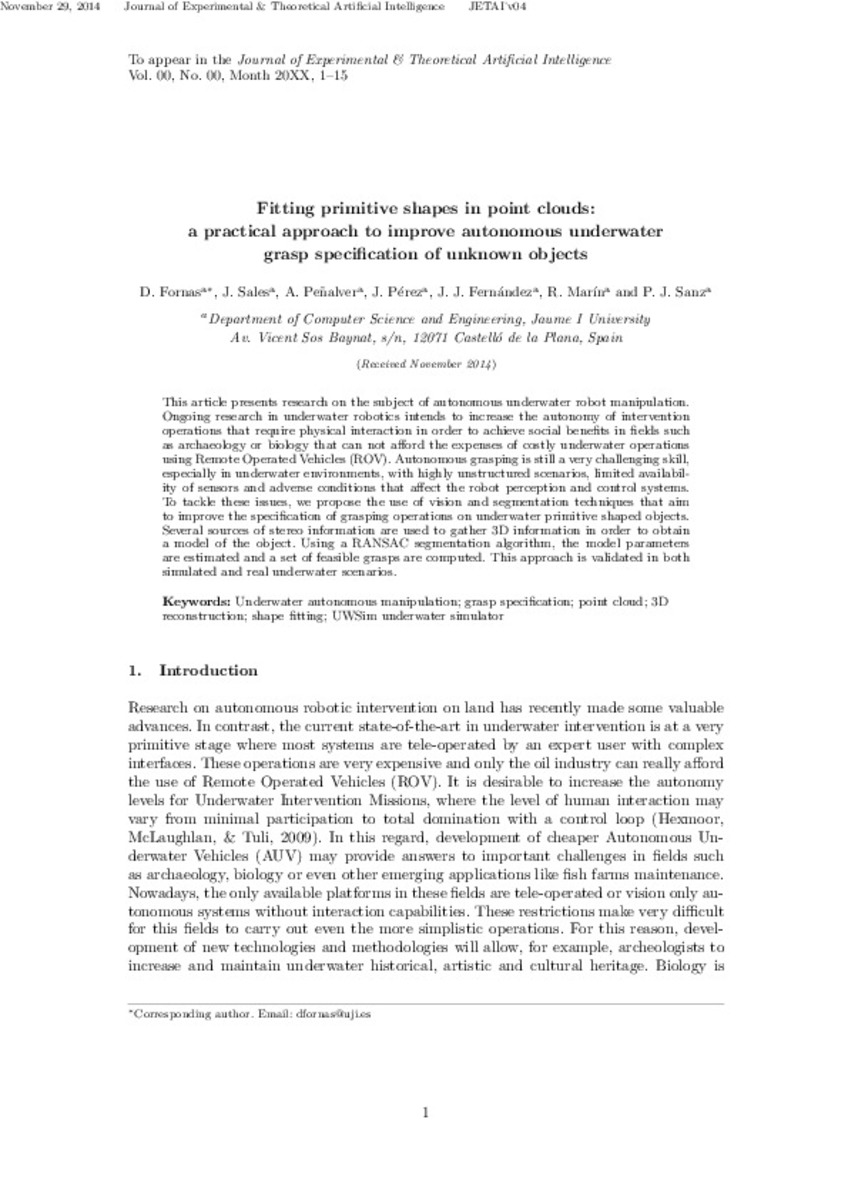Mostrar el registro sencillo del ítem
Fitting primitive shapes in point clouds: a practical approach to improve autonomous underwater grasp specification of unknown objects
| dc.contributor.author | Fornas Garcia, David | |
| dc.contributor.author | Sales Gil, Jorge | |
| dc.contributor.author | Peñalver Monfort, Antonio | |
| dc.contributor.author | Pérez Soler, Javier | |
| dc.contributor.author | Fernández Fresneda, José Javier | |
| dc.contributor.author | Marin, Raul | |
| dc.contributor.author | Sanz, Pedro J | |
| dc.date.accessioned | 2016-06-10T12:14:30Z | |
| dc.date.available | 2016-06-10T12:14:30Z | |
| dc.date.issued | 2015-04 | |
| dc.identifier.citation | Fornas, D., Sales, J., Peñalver, A., Pérez, J., Fernández, J. J., Marín, R., & Sanz, P. J. (2015). Fitting primitive shapes in point clouds: a practical approach to improve autonomous underwater grasp specification of unknown objects. Journal of Experimental & Theoretical Artificial Intelligence, 1-16. | ca_CA |
| dc.identifier.uri | http://hdl.handle.net/10234/160606 | |
| dc.description.abstract | This article presents research on the subject of autonomous underwater robot manipulation. Ongoing research in underwater robotics intends to increase the autonomy of intervention operations that require physical interaction in order to achieve social benefits in fields such as archaeology or biology that cannot afford the expenses of costly underwater operations using remote operated vehicles. Autonomous grasping is still a very challenging skill, especially in underwater environments, with highly unstructured scenarios, limited availability of sensors and adverse conditions that affect the robot perception and control systems. To tackle these issues, we propose the use of vision and segmentation techniques that aim to improve the specification of grasping operations on underwater primitive shaped objects. Several sources of stereo information are used to gather 3D information in order to obtain a model of the object. Using a RANSAC segmentation algorithm, the model parameters are estimated and a set of feasible grasps are computed. This approach is validated in both simulated and real underwater scenarios. | ca_CA |
| dc.description.sponsorShip | This research was partly supported by Spanish Ministry of Research and Innovation DPI2011-27977-C03 (TRITON Project), by Foundation Caixa Castelló Bancaixa PI-1B2011-17, by Universitat Jaume I PhD grants PREDOC/2012/47 and PREDOC/ 2013/46, and by Generalitat Valenciana PhD grant ACIF/2014/298. | ca_CA |
| dc.format.extent | 15 p. | ca_CA |
| dc.format.mimetype | application/pdf | ca_CA |
| dc.language.iso | eng | ca_CA |
| dc.publisher | Taylor & Francis | ca_CA |
| dc.relation.isPartOf | Journal of Experimental & Theoretical Artificial Intelligence Volume 28, Issue 1-2, 2016 | ca_CA |
| dc.rights | © 2016 Taylor & Francis Group. | ca_CA |
| dc.rights.uri | http://rightsstatements.org/vocab/InC/1.0/ | * |
| dc.subject | underwater autonomous manipulation | ca_CA |
| dc.subject | grasp specification | ca_CA |
| dc.subject | point cloud | ca_CA |
| dc.subject | 3D reconstruction | ca_CA |
| dc.subject | shape fitting | ca_CA |
| dc.subject | UWSim underwater simulator | ca_CA |
| dc.title | Fitting primitive shapes in point clouds: a practical approach to improve autonomous underwater grasp specification of unknown objects | ca_CA |
| dc.type | info:eu-repo/semantics/article | ca_CA |
| dc.identifier.doi | http://dx.doi.org/10.1080/0952813X.2015.1024495 | |
| dc.rights.accessRights | info:eu-repo/semantics/openAccess | ca_CA |
| dc.relation.publisherVersion | http://www.tandfonline.com/doi/abs/10.1080/0952813X.2015.1024495 | ca_CA |
Ficheros en el ítem
Este ítem aparece en la(s) siguiente(s) colección(ones)
-
ICC_Articles [420]







